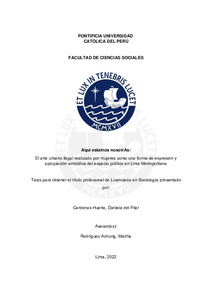| dc.contributor.advisor | Rodríguez Achung, Zoila Martha | |
| dc.contributor.author | Cardenas Huerta, Daniela Pilar | |
| dc.date.accessioned | 2022-07-12T17:06:51Z | |
| dc.date.available | 2022-07-12T17:06:51Z | |
| dc.date.created | 2022 | |
| dc.date.issued | 2022-07-12 | |
| dc.identifier.uri | http://hdl.handle.net/20.500.12404/22774 | |
| dc.description.abstract | Al hacer caso omiso a dictámenes tradicionales de los roles de género, las
artistas urbanas se apropian de los espacios públicos desde el trabajo artístico
e ilegal: graffiti y street art. El arte urbano ilegal es un rubro de investigación que
involucra el dialogo del campo artístico y el campo socio urbano (espacio
público). Por un lado, dentro del campo artístico, las artistas urbanas perfoman
la femineidad ajena al ideal masculino. Asimismo, en los testimonios y
experiencias se observan cómo, en el mundo del arte, se reproducen ciertos
patrones de desigualdad de género que reproducen estereotipos que impiden
percibir a la mujer como una creadora o artista. Además, para hacer arte urbano
ilegal es necesario cierto nivel de organización en el proceso de realización, esto
implica un trabajo colectivo que prevé por los riesgos latentes del trabajo artístico
y el espacio social. Por otro lado, en el campo socio urbano, el espacio público
se vive, experimenta y piensa de una manera particular para las mujeres. Por
ese motivo, el uso y el desplazamiento por la ciudad varía según las experiencias
de las artistas en los diversos distritos de Lima. En los testimonios, se observa
cierta fragmentación socio espacial en los desplazamientos de las artistas y la
disciplinas que realizan, esto principalmente por diferencias socioeconómicas y
socioculturales que influyen en prácticas culturales en cada uno de los distritos
de la ciudad. Sin embargo, es el acoso sexual un común denominador en la
experiencia cotidiana que evidencia la violencia estructural hacia las mujeres en
la ciudad de Lima Metropolitana. | es_ES |
| dc.description.abstract | By ignoring traditional dictates of gender roles, urban artists’ appropriate public
spaces through illegal work: graffiti and street art. Urban art is an area of research
that involves the dialogue between the artistic and the socio-urban field (public
space). On the one hand, within the artistic field, urban artists perform femininity
through their work by the representation of women outside the masculine ideal.
Likewise, in the testimonies and experiences, it is observed how, in the art world,
certain patterns of gender inequality are reproduced by stereotypes that prevent
women from being perceived as creators or artists. In addition, to make illegal
urban art, there is a certain level of organization in the process of realization, this
implies a collective work that foresees the latent risks of artistic work and social
space. On the other hand, in the socio-urban field, public space is lived,
experienced and thought in a particular way for women. For this reason, the use
and movement around the city varies according to the experiences of the artists
in the various districts of Lima. In the testimonies, a certain socio-spatial
fragmentation is observed in the movements of the artists and the disciplines they
carry out, mainly due to socioeconomic and sociocultural differences that
influence cultural practices in each of the city's districts. However, sexual
harassment is a common denominator in the daily experience that evidences
structural violence against women in the city of Metropolitan Lima. | es_ES |
| dc.language.iso | spa | es_ES |
| dc.publisher | Pontificia Universidad Católica del Perú | es_ES |
| dc.rights | info:eu-repo/semantics/openAccess | es_ES |
| dc.rights.uri | http://creativecommons.org/licenses/by-sa/2.5/pe/ | * |
| dc.subject | Mujeres--Perú--Lima Metropolitana--Condiciones sociales | es_ES |
| dc.subject | Arte callejero--Perú--Lima Metropolitana | es_ES |
| dc.subject | Espacios públicos--Perú--Lima Metropolitana | es_ES |
| dc.title | Aquí estamos nosotrAs: El arte urbano ilegal realizado por mujeres como una forma de expresión y apropiación simbólica del espacio público en Lima Metropolitana | es_ES |
| dc.type | info:eu-repo/semantics/bachelorThesis | es_ES |
| thesis.degree.name | Licenciado en Sociología | es_ES |
| thesis.degree.level | Título Profesional | es_ES |
| thesis.degree.grantor | Pontificia Universidad Catolica del Peru. Facultad de Ciencias Sociales | es_ES |
| thesis.degree.discipline | Sociología | es_ES |
| renati.advisor.dni | 06176995 | |
| renati.advisor.orcid | https://orcid.org/0000-0002-4617-2778 | es_ES |
| renati.author.dni | 71635503 | |
| renati.discipline | 314086 | es_ES |
| renati.juror | Ruiz Bravo, Patricia | es_ES |
| renati.juror | Dammert Guardia, Manuel | es_ES |
| renati.juror | Rodríguez Achung, Zoila Martha | es_ES |
| renati.level | https://purl.org/pe-repo/renati/level#tituloProfesional | es_ES |
| renati.type | https://purl.org/pe-repo/renati/type#tesis | es_ES |
| dc.publisher.country | PE | es_ES |
| dc.subject.ocde | https://purl.org/pe-repo/ocde/ford#5.04.01 | es_ES |






